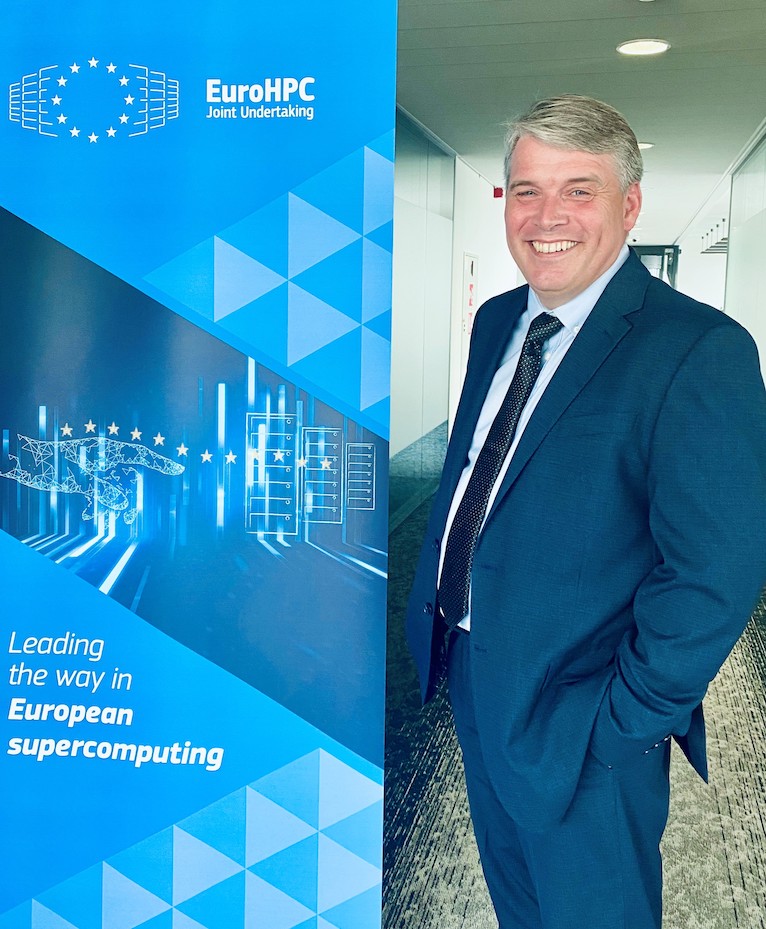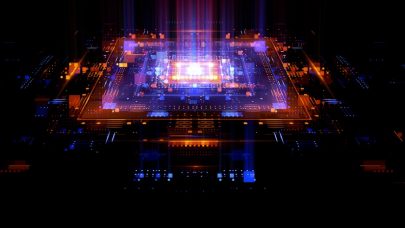While much of the HPC community’s attention is fixed on SC20’s flood of news and new product announcements, Anders Dam Jensen, the newly-minted executive director of the European High Performance Computing Joint Undertaking, provides a glimpse into Europe’s action plans for building out the European HPC ecosystem in this interview with HPCwire.
HPCwire: Can you summarize what the European Union is doing in HPC, especially the EuroHPC Joint Undertaking?
Anders Jensen: We’re pulling together the resource of the EU, of 32 countries, including some non-EU member states, that are participating in the EuroHPC Joint Undertaking, along with some participating private-sector partners. Our aim is to give every participating country more than they would otherwise have. Right now, our focus is on infrastructure, procuring eight supercomputers jointly with participating countries by the end of this year, and having all eight operational by the end of 2021. That’s five petascale and three precursor to exascale (pre-exascale) machines.

For each procurement of a pre-exascale machine, multiple participating countries acting together as a consortium contribute 50 percent of the cost of the machine and the Joint Undertaking funds the other 50 percent. Technically, the JU owns these large supercomputers and manages 50 percent of the capacity, while the countries participating in each pre-exascale procurement together control the other half of the machine’s time. The 50 percent of the capacity the JU manages will be awarded through a peer review process to users from throughout Europe.
The formula is different for petascale-class machines, where EuroHPC funds up to 35 percent of the cost in return for controlling up to 35 percent of the access time. The hosting entity’s consortium behind each of these procurements manages the remaining majority of the capacity and owns the machines. That’s the infrastructure side. Our vision is to have eight machines under contract this year, five petascale and 3 pre-exascale systems, all to be operational by the end of next year.
The research and innovation agenda’s aim is to build an HPC ecosystem for Europe. We’ve fallen behind the U.S. and Japan, and this is what EuroHPC is seeking to fill. The aim is for Europe to provide state-of-the-art equipment, and the most ambitious part is to develop a processor through EPI, the European Processor Initiative. When we get to exascale machines, our objective is to have at least one of them with a significant European technology footprint.
The third part of the research and innovation agenda is about skills and training. Some countries have been doing HPC for decades and others are relatively new to it, so we have a very diverse level of knowledge of HPC in Europe. We’re looking to broaden the knowledge and use of HPC across Europe. We’ll have a new call for proposals concerning this. It’s under preparation and will be published soon.
HPCwire: What is your role as executive director of EuroHPC?
Jensen: I’ve been in this role since September, so for just 6 weeks. On paper, my role is to implement the decisions of the Governing Board and to manage the JU on a daily basis. In practice, it is like running a startup with an intensive agenda! The work done by my predecessors Gustav Kalbe [former interim executive director of EuroHPC] and Jean-Francois Buggenhout [former interim executive director of EuroHPC] under the leadership of Thomas Skordas [Director in the European Commission] was absolutely impressive. They lined up everything necessary for me to take over and start signing the procurement contracts.
Everyone was waiting for EuroHPC to become an autonomous entity. This wasn’t easy to do. It required a lot of work and time, and today we’re still in start-up mode. We became autonomous from the European Commission only on September 23. It means that we are no longer operating under the supervision of the European Commission and that we are now solely responsible for our operations and we have the capacity to implement our own budget. It was nice that there was money in the account for signing contracts but at the same time there was a lot to handle! Luckily I have a team of people with the right spirit to make things happen.
We signed the LUMI contract with HPE the day before press conference, for a peak 550-petaflop supercomputer that will start operations in 2021 at CSC’s datacenter in Kajaani, Finland. Before that, we signed a contract for Leonardo, a peak 320-petaflop machine from Atos that will be located at CINECA in Italy.
My job is to manage the EuroHPC organization and I’m also its legal representative. There’s a lot still to do, but thanks to the great work of my predecessors I sometimes feel as if I’ve come in for the victory lap. The people in the Commission managed on the political side to get agreements about co-funding between countries and the EU, and then between consortia of countries and the EU, without which the JU could not succeed. In my opinion, this kind of collaboration is what the European Union is all about.
HPCwire: How is the European approach to HPC different from the strategies in the U.S., China and Japan?
Jensen: Getting agreement among many countries rather than just one is a key thing that makes the European approach more challenging, but this is what the EU should be all about: making it a win-win for all the participating countries, giving them more than they would likely be able to get acting alone.
HPCwire: What are Europe’s main assets in supercomputing?
Jensen: We have a very broad HPC user and application base. Some European countries have been working at the forefront of HPC since the start of the supercomputer era. Europe is not only a driving force behind supercomputing applications development, for example for simulations and scientific research, but it has also a leading position in fundamental research on emerging technologies such as quantum computing.
Moreover, Europe has a strong position in other HPC-related areas such as cooling technology, board and system integration or software tools.
HPCwire: What are the biggest challenges Europe faces in HPC?
Jensen: I think we have to recognize that our challenge is on the hardware technology side. We’ve done very well with applications and other software but by using HPC systems from the U.S. and Japan. Another challenge, as I mentioned, is that European countries are at very different levels of HPC expertise and experience, and the challenge is to even this out. One of my tasks is to lift up those that want lifting, so we can tap into the research talent that exists in all of the countries. The consortia include both highly experienced and less experienced countries at HPC, so there’s a mechanism in place that’s already making progress. Another important concept is the centers of excellence and competency centers, where each country has support to access HPC resources. The JU-managed computers will be available to every single country and in each country there will be a focal point for accessing these resources.
HPCwire: What are the main success criteria for the Joint Undertaking?
Jensen: The main criterion is to deliver on the agenda that’s been established by the European Union. One important goal is an exascale machine with a European technology footprint, and another is to provide HPC access to researchers in every participating European country and ensure that HPC experience is raised in countries that haven’t been in a position to do this adequately before.
HPCwire: How will user requirements be built into these procurements?
Jensen: Procurements have been done in close collaboration with the hosting entities, and they in turn collaborated closely with their user communities to define requirements for the systems. Very significant discussions took place with each hosting institution before the procurements. An important goal for the JU was to get a diverse technology base across the EU, and not just eight machines with the same architecture, but machines that excel on different types of workloads, where users could gain experience with a variety of architectures.
HPCwire: How important for EuroHPC is support for European industries?
Jensen: There’s a lot of focus on this. The new regulation, currently under discussion between the Commission and national capitals, will set the JU’s agenda for the next decade. It envisions up to 20 percent of the EuroHPC compute time allocated for industry and SMEs. We already aim at granting free of charge computing access time to industrial applications related to research and innovation activities funded by the EU, but we intend to increase this to allow future projects, for instance under Horizon Europe or the Digital Europe Programme, to have access to these machines. And lastly, we need to work with the hosting entities, participating states and users which include SMEs to determine whether access for payment is a way of strengthening European industrial use of these machines.
HPCwire: What about SMEs? Will EuroHPC help them, too?
Jensen: SMEs are one of our priorities because they normally can’t afford their own supercomputers. There’s a very strong desire to give SMEs access to HPC in order to accelerate innovation and help drive the European economy. The Fortissimo programs for SMEs has been very successful, as has the SHAPE program. Of course, we can’t deal with all 200,000 SMEs that exist in Europe but these programs have had many good successes and we will try to pursue this effort.
HPCwire: What is the relationship between EuroHPC and PRACE?
Jensen: We are in the process of defining that. PRACE is well respected for managing time on supercomputers within Europe. We’re discussing how we can work together. There’s a lot of overlap. The specifics aren’t nailed down yet, but there’s no question we’ll work together in a way that’s beneficial to users, and we’ll coordinate to avoid duplication of effort.
HPCwire: How will EuroHPC balance support for creating a strong European HPC supply chain with the need of European scientists and engineers to have access to the best HPC systems, no matter where in the world they come from? How open will the EuroHPC procurements be to suppliers based in other parts of the world?
Jensen: It’s a balance we need to strike. The EU has clear rules to ensure open and transparent procurements. The calls for tenders have openly stated that vendors need to live up to a stated set of requirements, including how European technologies might fit into the bids. So far the most powerful EuroHPC supercomputer is LUMI, to be built by HPE. Atos has won a couple of contracts for machines. We want a broad range of bidders and a broad range of machines.
HPCwire: There is an HPC skills gap throughout the world. How will Europe address the skills gap?
Jensen: We are in the process of starting two big projects that were launched on September 1, both being coordinated by HLRS in Stuttgart. EuroCC aims to bring the participating European countries to a common high level in HPC and AI. This is the initiative that will establish national competence centers in the participating countries. Its Coordination and Support Action CASTIEL will link together the national centers throughout Europe to ensure successful collaboration among the participating countries.
HPCwire: The European Processor Initiative has established ambitious goals to achieve by 2025, including the development of an HPC processor, an embedded processor for automated vehicles and other AI applications, and an accelerator based on the RISC-V standard. What progress that the EPI made so far?
Jensen: The first phase is completing and we’re about to start the second phase. The EPI consortium will report in January 2021. It’s exactly what we should be doing to help get sovereignty over HPC technology in Europe. Important work was done in the initial phase to meet the objectives of that phase. Now we’re defining how to move forward. The most visible result is the creation of SiPearl, whose role is to commercialize the IP and disseminate it into industrial activities.
HPCwire: Finally, the EU plans to invest one billion euros over ten years in the quantum computing flagship program that is now under way. Will EuroHPC be involved in this program or in any aspect of quantum computing?
Jensen: The Quantum Technologies Flagship isn’t formally connected with the EuroHPC JU, but one future ambition of EuroHPC is to deploy quantum computing capability that connects with HPC. The member states haven’t agreed on this yet, but it could be really interesting. Europe has a real chance of being a global leader in QC.

































































